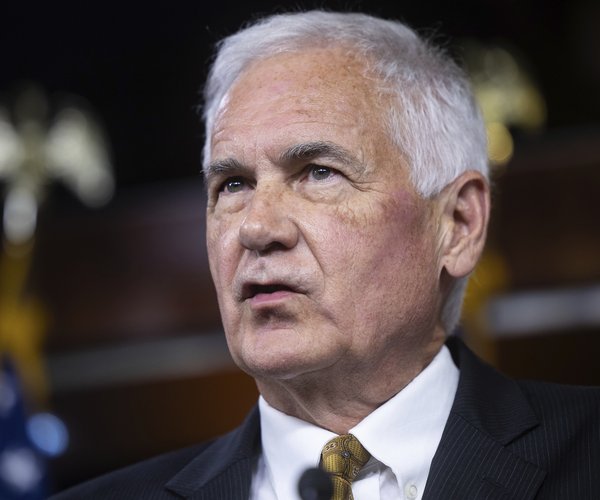Drive Interstate 5 south toward Los Banos and veer west toward the Pacheco Pass.
Your journey will take you past California’s largest off-stream water storage facility — San Luis Reservoir.
It is currently at 48 percent of its designed capacity of being able to hold 2.039 million acre feet of water. If this were a non-drought year — which it isn’t – San Luis Reservoir would be at 77 percent full.
If the state’s fifth largest reservoir were at its historic average there would be 600,000 acre feet of additional water for release back into the California Aqueduct to serve Southern California and large corporate farms in the southwest portion of the San Joaquin Valley. Based on Manteca’s per capita water consumption that is enough liquid gold to support more than 3.5 million people for a year. If San Luis were at capacity, the difference between what now sits in the reservoir and when it is filled to the brim would address the annual needs of 5 million Californians.
Is it wishful thinking that San Luis Reservoir that is not a flood control manmade lake by any stretch of the imagination would be at 100 percent capacity today as California heads into what could be a sixth consecutive year of drought?
Absolutely not.
The reason is that in January and February storms sent 5.5 million acre feet flowing into the Delta. Of that, 852,000 acre feet of water went south into the pumps near Tracy to start the journey southward. If 2 million acre feet had been pumped instead and left 3.5 million acre feet of water flowing into San Francisco Bay over 59 days, a full San Luis Reservoir would have provided a good cushion for south state residents and farmers farther south. It would also take pressure off reservoirs that capture Sierra snowmelt further benefitting those cities and farmers as well as the cities and farmers of those watersheds that feed the Delta. And because of that, there would be additional water supplies later in the year as summer heat bakes the state to help address environmental concerns as well as struggling fish populations.
So why didn’t that happen? Two words — federal bureaucrats. Or more precisely, federal water bureaucrats concerned about the endangered Delta Smelt who have severely scaled back pumping near Tracy not based on hard scientific research but hysteria whipped up by environmentalists.
It is rightfully described as hysteria because more than seven years of trying to save the Delta Smelt by sacrificing additional water that’s close to the equivalent capacity of Shasta Dam — the state’s largest water storage facility — the Delta Smelt are still declining. Research points to predators of being a big factor including non-native bass and their ferocious appetites that ironically thrive better in more abundant water flows.
Senator Dianne Feinstein’s rider to a water bill now being considered by Congress would allow federal regulators to run the pumps at a bit more than half of their capacity. At the same time the rider calls for $558 million to help California build desalination plants, create more water storage and fund reclamation projects.
How the pumps are operated near Tracy is one reason why more than a few people argue that a large chunk of the damage of the current drought — such as tearing out orchards for lack of water, leaving farm field fallow, and forcing an increase in groundwater pumping that leads to a long-list of long-term sustainability and environmental concerns —is indeed manmade.
Making more effective use of winter runoff to fill off-stream reservoirs such as San Luis to capacity is a common sense and virtually no-cost alternative. It’s been accurately pointed out that adding reservoirs in the Sierra makes no sense if there isn’t more snow run-off to capture. But using San Luis more effectively and creating more reservoirs south of the pumps even if they are primarily to recharge the vastly over drafted Southern San Joaquin Valley watershed makes sense. It is a way of taking better advantage of California’s rainy months and positioning the state to better address urban, farm, fish, and environmental water needs during the dry summer and fall.
That would require pumps to perhaps operate at max during the winter rainy season.
So what about the Delta Smelt that are supposedly being decimated every time pumping is increased at Tracy?
There already is a successful hatchery operation dedicated to the Delta Smelt. A strategy that builds on that hatchery approach and reintroduces the fish to other parts of the Delta where they were once found in large numbers away from the pumps would seem reasonable except to those that hold onto the “pumps-are-killing-the-Delta-Smelt” theory. That’s because if the Delta Smelt can’t grow in numbers elsewhere in the Delta, it would underscore the argument it’s not how much water that flows into the Delta that counts but rather controlling predators especially those that are non-native.
Conservation — essentially wiser use of water by urban and farming interests alike — was already reducing the amount of water used per capita in cities and per acre to grow food long before the current drought hit.
While we will need more desalinization plants and perhaps more surface storage, it is clear that the biggest impact for the least cost by far is more effective management of the water storage and purveyance systems already in place.
And it all starts less than 20 miles west of Manteca in the giant pumps that feed the California Aqueduct near Tracy.






